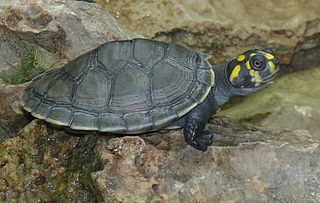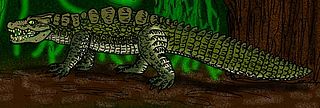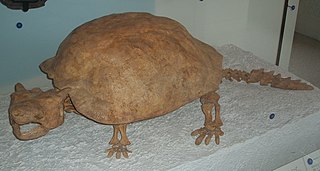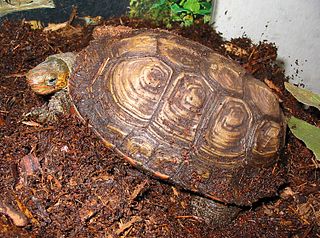
Podocnemididae is a family of pleurodire (side-necked) turtles, once widely distributed. Most of its 20 genera and 30 species are now extinct. Seven of its eight surviving species are native to South America: the genus Peltocephalus, with only one species ; and the genus Podocnemis, with six living species of South American side-necked river turtles. There is also one genus native to Madagascar: Erymnochelys, the Madagascan big-headed turtle, whose single species E. madagascariensis.

The Cochin forest cane turtle, also known as Kavalai forest turtle, forest cane turtle or simply cane turtle, is a rare turtle from the Western Ghats of India. Described in 1912, its type locality is given as "Near Kavalai in the Cochin State Forests, inhabiting dense forest, at an elevation of about 1500 feet above sea level". Only two specimens were found at that time, and no scientist saw this turtle in the next 70 years. It was finally rediscovered in 1982, and since then a number of specimens have been found and some studies have been conducted about its affiliation and habits.

Macrochelys is a genus of very large freshwater turtles in the family Chelydridae from Southeastern United States. Only a single extant species was recognized until a 2014 study divided it into two, or possibly three species.

Trilophosuchus is an extinct genus of mekosuchine crocodilian from Australia. Unlike living crocodilians, it is hypothesized to have been terrestrial. Trilophosuchus was approximately 1.5 metres (4.9 ft) in length. It had a short skull with three ridges on top and large eyes. Fossils have been found at Riversleigh in north-western Queensland, and are Miocene in age. Only a single species has been described, the type species T. rackhami.

Thalassodromeus is a genus of pterosaur that lived in what is now Brazil during the Early Cretaceous period, about 100 million years ago. The original skull, discovered in 1983 in the Araripe Basin of northeastern Brazil, was collected in several pieces. In 2002, the skull was made the holotype specimen of Thalassodromeus sethi by palaeontologists Alexander Kellner and Diogenes de Almeida Campos. The generic name means "sea runner", and the specific name refers to the Egyptian god Seth due to its crest being supposedly reminiscent of Seth's crown. Other scholars have pointed out that the crest was instead similar to the crown of Amon. A jaw tip was assigned to T. sethi in 2005, became the basis of the new genus Banguela in 2014, and assigned back to Thalassodromeus as the species T. oberlii in 2018. Another species was named in 2015 based on a supposed crest fragment, but this was later shown to be part of a turtle shell.

Stupendemys is an extinct genus of freshwater side-necked turtle, belonging to the family Podocnemididae. It is the largest freshwater turtle known to have existed, with a carapace over 2 meters long. Its fossils have been found in northern South America, in rocks dating from the Middle Miocene to the very start of the Pliocene, about 13 to 5 million years ago. Male specimens are known to have possessed bony horns growing from the front edges of the shell and the discovery of the fossil of a young adult shows that the carapace of these turtles flattens with age. A fossil skull described in 2021 indicates that Stupendemys was a generalist feeder.

Meiolania is an extinct genus of meiolaniid stem-turtle native to Australasia from the Middle Miocene to Late Pleistocene and possibly Holocene. It is best known from fossils found on Lord Howe Island, though fossils are known from mainland Australia, New Caledonia, and possibly Vanuatu and Fiji.

The Pleurodira are one of the two living suborders of turtles, the other being the Cryptodira. The division between these two suborders represents a very deep evolutionary divide between two very different types of turtles. The physical differences between them, although anatomical and largely internal, are nonetheless significant, and the zoogeographic implications of them are substantial. The Pleurodira are known more commonly as the side-necked turtles and the name Pleurodira quite literally translates to side neck, whereas the Cryptodira are known as hidden-necked turtles. The Pleurodira turtles are currently restricted to freshwater habitats in the Southern Hemisphere, largely to Australia, South America, and Africa. Within the Pleurodira, three living families are represented: Chelidae, also known as the Austro-South American side-necked turtles, the Pelomedusidae, also known as the African mud terrapins, and the Podocnemididae, also known as the American side-neck river turtles. However, they are a cosmopolitan clade across the Cretaceous and Cenozoic, and even occurred in marine environments around the world.

Desmatophoca is an extinct genus of early pinniped that lived during the Miocene, and is named from the Greek "phoca", meaning seal. A taxon of the family Desmatophocidae, it shares some morphological similarities with modern true seals. Two species are recognized: Desmatophoca oregonensis and Desmatophoca brachycephala. Little information exists regarding Desmatophoca, due to the small number of fossil samples obtained and identified.

Rhinoclemmys is a genus of turtles in the family Geoemydidae, the only genus in the subfamily Rhinoclemmydinae. Member species of the genus are commonly known as the Neotropical wood turtles and are the only geoemydids known from the Americas. As such, they have adapted to a wide range of habitats, which is reflected in the species' common names.
Pseudodontornis is a rather disputed genus of the prehistoric pseudotooth birds. The pseudotooth birds or pelagornithids were probably rather close relatives of either pelicans and storks, or of waterfowl, and are here placed in the order Odontopterygiformes to account for this uncertainty. Up to five species are commonly recognized in this genus.
Eogavialis is an extinct genus of eusuchian crocodylomorph, usually regarded as a gavialoid crocodylian. It superficially resembles Tomistoma schlegelii, the extant false gharial, and consequently material from the genus was originally referred to Tomistoma. Indeed, it was not until 1982 that the name Eogavialis was constructed after it was realised that the specimens were from a more basal form.

Gryposuchus is an extinct genus of gavialoid crocodilian. Fossils have been found from Argentina, Colombia, Venezuela, Brazil and the Peruvian Amazon. The genus existed during the Miocene epoch. One recently described species, G. croizati, grew to an estimated length of 10 metres (33 ft). Gryposuchus is the type genus of the subfamily Gryposuchinae, although a 2018 study indicates that Gryposuchinae and Gryposuchus might be paraphyletic and rather an evolutionary grade towards the gharial.
Amphimachairodus is an extinct genus of large machairodonts belonging to the clade known as Eumachairodontia along with relatives like Smilodon and Homotherium. It is also a member of the tribe Homotherini within Machairodontidae and is most closely related to such species as Xenosmilus, Homotherium itself, and Nimravides. It inhabited Eurasia, Northern Africa and North America during the late Miocene epoch.

Ocepechelon is an extinct genus of giant protostegid sea turtle known from Late Cretaceous phosphatic deposits of the Oulad Abdoun Basin, Khouribga Province of Morocco. It is known from the holotype OCP DEK/GE 516, a complete but isolated 70-cm-long skull, making it one of the largest marine turtles ever described. It was first named by Nathalie Bardet, Nour-Eddine Jalil, France de Lapparent de Broin, Damien Germain, Olivier Lambert and Mbarek Amaghzaz in 2013 and the type species is Ocepechelon bouyai. The feeding apparatus of Ocepechelon, a bony pipette-like snout, is unique among tetrapods and shares unique convergences with both syngnathid fishes and beaked whales.

Khunnuchelys was a genus of trionychine turtle from the Late Cretaceous of Asia. Three species are known, K. erinhotensis, the type species, K. kizylkumensis, and K. lophorhothon. K. erinhotensis is known from the Iren Dabasu Formation in China from the late Turonian until the middle Campanian. K. kizylkumensis is known from the late Turonian Bissekty Formation of Uzbekistan. The third species, described in 2013 by Danilov et al., is known from the early to middle Campanian aged Bostobe Formation of Kazakhstan.

Megalochelys is an extinct genus of cryptodiran tortoises that lived from the Miocene to Pleistocene. They are noted for their giant size, which is among the largest of any known testudine, with a maximum carapace length over 2 m (6.5 ft) in M. atlas. During the dry glacial periods it ranged from western India and Pakistan to as far east as Sulawesi and Timor in Indonesia, though the island specimens likely represent distinct species.

Astorgosuchus is an extinct genus of crocodilian, closely related to true crocodiles, that lived in Pakistan during the late Oligocene period. It contains a single species, A. bugtiensis, which was originally named as a species of Crocodylus in 1908 and was moved to its own genus in 2019.
Shuangbaisaurus is genus of theropod dinosaur, possibly a junior synonym of Sinosaurus. It lived in the Early Jurassic of Yunnan Province, China, and is represented by a single species, S. anlongbaoensis, known from a partial skull. Like the theropods Dilophosaurus and Sinosaurus,Shuangbaisaurus bore a pair of thin, midline crests on its skull. Unusually, these crests extended backwards over the level of the eyes, which, along with the unusual orientation of the jugal bone, led the describers to name it as a new genus. However, Shuangbaisaurus also possesses a groove between its premaxilla and maxilla, a characteristic which has been used to characterize Sinosaurus as a genus. Among the two morphotypes present within the genus Sinosaurus, Shuangbaisaurus more closely resembles the morphotype that is variably treated as a distinct species, S. sinensis, in its relatively tall skull.

Caninemys is an extinct genus of large freshwater side-necked turtle, belonging to the family Podocnemididae. Its fossils have been found in Brazil and Colombia, in rocks dating back from the middle to late Miocene.















